

Tech, girls' science club to expand programs in public school. A dynamic partnership among Montana Tech, a girls’ science club and the Butte school district is bubbling to the surface.
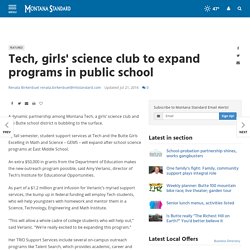
By fall semester, student support services at Tech and the Butte Girls Excelling in Math and Science – GEMS – will expand after-school science programs at East Middle School. An extra $50,000 in grants from the Department of Education makes the new outreach program possible, said Amy Verlanic, director of Tech’s Institute for Educational Opportunities. A healthy dose of scepticism. I want my students to be sceptics.

I believe that in the present age scepticism is more important than ever. Easy access to information, ease of publishing, scams and confidence tricksters combine to create a climate where blind trust is dangerous for our security, our finances and our knowledge bases. Algodoo Educator Review. How Can Teachers Use It?

Think of Algodoo as a way for both teachers and students to create, share, and remix interactives, virtual experiments, lessons, and demos that build conceptual understanding of physics. Use Algodoo as an assessment tool: Ask students to model their learning by designing models, experiments, or games that demonstrate what they've learned. Since users can share their creations and lessons, teachers can also publish their work and their students' work, helping a larger global community and showing students how to participate responsibly online. Algodoo can also be a good brainstorming and testing tool; students can design models aimed at solving larger real-world problems, or as safe and cheap preparatory work for actual builds and projects. Energy projects help North Prairie students apply science to life - Lake County News-Sun.
Sixth grader Allie Dukas never gets to charge her cell phone on road trips.
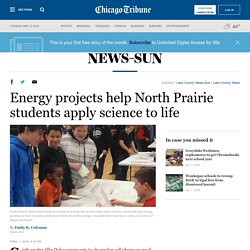
That's how she came up with the idea of a solar-powered cell phone charger for her science project, for which she had to draw up a prototype and answer questions about how energy works. The project was part of a grant-funded unit that allowed students at Winthrop Harbor's North Prairie Junior High to apply the energy concepts they were learning to the real world through hands-on activities, said science teacher Irina Stan. Along with fellow science teacher Megan Richardt, Stan headed the five sixth- and seventh-grade classes that completed the unit. The coalition of energy providers that funded the grant provided different lab stations for the monthlong unit, along with an energy professional who guided 12 students through their own junior high, using various instruments so they could figure out how efficiently the school was using electricity, Stan said. Education Week. Cheney 7th-graders create innovations for Iditarod project.
In the “I Will Survive!”
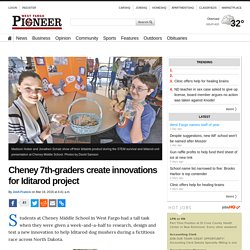
Project, 96 seventh-grade students in groups of two or three created a tangible invention to help the dogs or mushers complete and survive the long race across North Dakota. They presented their projects Friday in the school’s lunch commons. Before students started their projects, they heard a presentation from a local veterinarian who discussed the problems and obstacles dogs and mushers face during an Iditarod race. The real Iditarod race began in Alaska in 1973, with a route from Anchorage to Nome. Mushers and dogs can face whiteout conditions and extremely cold temperatures.
Grace Planteen and Victoria Smith created a “doggy care kit” that includes a blanket with a heating system, a dog booty for paws and organic dog treats. “We spent like a whole day thinking of many different designs and it just came to us,” Smith said. Items in the doggy care kit fit into a lightweight pack the girls designed to fit on the dogs. Middle School Maker Journey: The Making of a Mantra. Care.
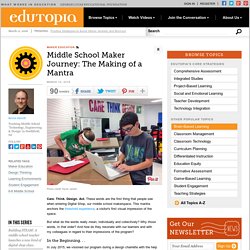
Think. Design. Act. These words are the first thing that people see when entering Digital Shop, our middle school makerspace. This mantra anchors the threshold experience, a visitor's first visual impression of the space. But what do the words really mean, individually and collectively? In the Beginning. . . In July 2015, we visioned our program during a design charrette with the help of designer/consultant David Jakes. We wanted our kids to care about problems they see in the world, acknowledging our desire to have empathy become the anchoring force in our learning community. Communicate .. Create .. EdTech: Integrating STEM with Physical Education. Clemson University recently published a study that illustrated the growing trend of obesity in American adults over the past 25 years.
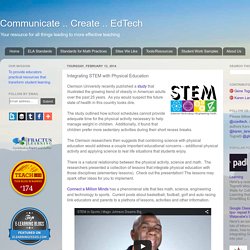
As you would suspect the future state of health in this country looks dire. The study outlined how school schedules cannot provide adequate time for the physical activity necessary to help manage weight in children. Additionally, it found that children prefer more sedentary activities during their short recess breaks. The Clemson researchers then suggests that combining science with physical education would address a couple important educational concerns – additional physical activity and applying science to real life situations that students enjoy. There is a natural relationship between the physical activity, science and math. Connect a Million Minds has a phenomenal site that ties math, science, engineering and technology to sports.
The site also pulls in well-known athletes, like Magic Johnson (above) and Jeff Gordon, to introduce the units. STEM using pancakes coding.